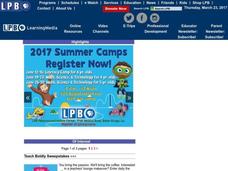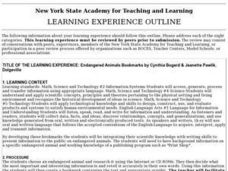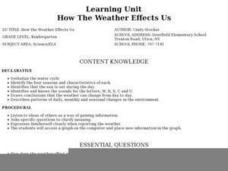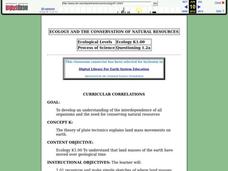Curated OER
Graphing Data from the Chemistry Laboratory
Students graph and analyze data using a spreadsheet.
Curated OER
Wind in the Willows
Students find further information about ows in their region or outside of their region. They prepare questions for Elders and community members in their own village and share their findings with students in other villages.
Curated OER
Solar Oven
Students construct a solar oven using cardboard, duct tape, aluminum foil and other materials. They use the solar oven to cook something and keep a journal of their project.
Curated OER
Taking Apart Electrical Appliances
High schoolers discover that electrical appliances are made up of individual components that work together. They, with partners, demonstrate to others how their piece of equipment or appliance works by taking it apart and examining the...
Curated OER
Days of '49: "I've Been Toiling Hard for the Last Two And a Half Years"
Students trace the stages of gold mining in California. They discuss the life of a gold miner and how the discovery of gold influenced towns and cities in California during the 1949 Gold Rush.
Curated OER
Catch a Dream
Students apply the concepts of air pressure, the Bernoulli Effect, and angle of attack to build their own model planes out of paper, plastic, wooden rods, and drinking straws.
Curated OER
Up, Up, and Away
Students investigate the laws of physics that govern the flight of helicopters and airplanes. They build and launch a model rotor, simulating rotors used on helicopters to provide lift.
Curated OER
Endangered Animals Bookmarks
Students conduct research on various endangered animals. They conduct Internet research, create a bookmark with information about their selected animal, and sell the bookmarks to raise money for an organization dedicated to endangered...
Curated OER
How The Weather Effects Us
Students discover how weather affects their lives. They review the climates of Florida, Alaska and New York. They need choose the place they would most like to live in based on the climate of that state.
Curated OER
Name That Point!
Young scholars compare projectile point attributes, identify and classify points, and match projectile points to a chronology.
Curated OER
Who Are We? An Introduction to the Life Within Our Bodies
Students examine cell structure, cell division, and the basic structure of DNA. They read and discuss a case study of DNA research, answer discussion questions, role-play the process of mitosis, and complete a DNA Fact or Fiction worksheet.
Curated OER
GMOs: Should We Grow Them?
Students examine the ethics of biotechnology and genetically modifying various organisms. They complete various activities and labs on GMOs and then write a position paper regarding their individual opinions on the subject.
Curated OER
Keep the Environment Clean
Students discuss ways our environment becomes polluted. They make a list of ways to keep it clean.
Curated OER
Oceanography (Rivers and Streams)
Second graders examine the characteristics of streams and rivers. They identify the types of resources lakes, ponds and oceans provide. They ask questions to complete the lesson.
Curated OER
Meteorology (Condensation)
Second graders define condensation and evaporation. They identify and describe the steps in the water cycle. They ask questions to end the lesson.
Curated OER
Plants
Third graders study the factors necessary for plant growth and how plants adapt to their environment. They examine ow different plants require different environments to thrive.
Curated OER
Ocean Currents
Fourth graders work in groups to research ocean currents and create posters with their findings. They locate the patterns and names of major ocean currents and identify them on a map. Students also use red pencil to show ocean currents...
Curated OER
Oceanography: Understanding the Relationship Among Ocean Food Chains
Fourth graders explore relationships among organisms involved in ocean food chains to investigate interdependence of the organisms.
Curated OER
Oceanography
Fourth graders define new vocabulary associated with oceanography. They locate and label the four oceans. They also identify features of the ocean floor.
Curated OER
Structure of the Earth
Sixth graders examine the layers of the Earth and the changes that take place on a daily basis. They look at the layers of a boiled egg to relate them to the layers of the Earth.
Curated OER
Structure of the Earth
Sixth graders define atmosphere and hydrosphere, explore through experimentation how the atmosphere was formed, and describe the layers of the Earth's atmosphere and their distances.
Curated OER
Ecology And the Conservation of Natural Resources
Students study Alfred Wegener's theory of continental drift and how the continents were connected in one large land mass called Pangaea. They examine plate tectonics and the theory that the earth's surface is composed of large moving...
Curated OER
Earth's History
Seventh graders study the law of superposition by creating models of fossils in layers of rock. They examine how fossils are usually found in sedimentary rock which leads to the study of geologic history in those rocks.
Curated OER
Population Dynamics
Students discover how organisms are dependent on one another for survivial. They also discuss how to conserve natural resources. They compare and contrast the different types of symbiotic relationships as well.

























